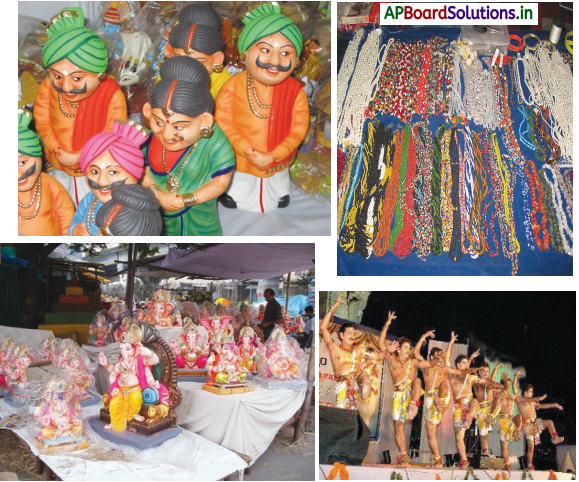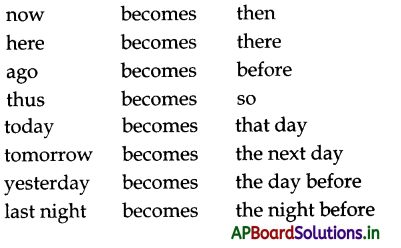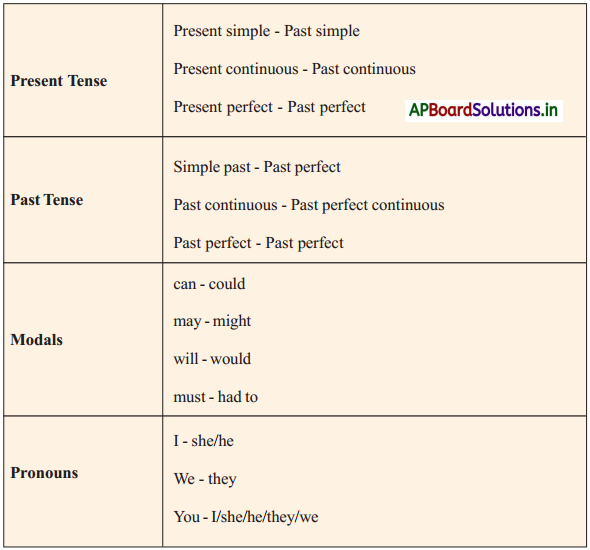Telangana SCERT 8th Class English Study Material Telangana Unit 6A The Story of Ikat Textbook Questions and Answers.
TS 8th Class English Guide Unit 6A The Story of Ikat
Pre – Reading :
Look at the pictures given below and answer the questions that follow:

Question 1.
What do you see in these pictures? Where do you find them?
Answer :
In these pictures I see handicrafts, wooden toys made in Nirmal, beads and pearl necklaces, Ganesh idols in Hyderabad and artistes performing Perini Siva Tandavam.
Question 2.
i) Why did the men make up themselves differently?
ii) Do you find anything unique in the decoration of the men in the picture?
iii) What could be the occasion for this decoration?
Answer :
i) The men were performing a special dance called Perini Siva Tandavam. So, they had traditional Puranic make up.
ii) So they wore attractive ornaments and attire suitable to the performance of puranic characters.
iii) The occasion may be the performance of Perini Siva Tandavam
![]()
Question 3.
Are these handicrafts and the make up a part of our culture? Give reasons to your answers.
Answer :
These handicrafts and make up are a part of our culture. These are the articles which enrich our tradition and culture focusing the reputation of our state all over the world.
Oral Discourse Talk on – Art and cultural forms of your area.”
The art and culture of Telangana is a fusion of the Telugu and Persian culture dating back to the Nizams and Mughals. Coming to art Nirmal Arts, Deccani Paintings, Kalamkari Paintings, Cheriyal Scroll Paintings in Telangana are worth watching and also buying. Sculptures made of stone, marble or wood are made in lelangana into various animal and birds forms. Sculptures of deities in various lurms in intricate and aesthetic styles are created by artisAnswer : Examples of fine xulptures can be seen in the Ramappa temple in Warangal and the Alampur It’mples in Mahaboobnagar. Telangana has many museums such as Salar Jung Museum, Hyderabad Museum, Nizam Museum, National History Museum (located inside the Nehru Zoological Park in Hyderabad) etc. Banjara needle craft is practised by the Banjaras or tribals of Telangana.The bronze castings of lilangana are world famous.
l’elangana has a music tradition of Carnatic music and folk music. The different forms of folk music are Oggukatha, Sarada Kala etc. The dances include Perini Shivathandavam, Gobbi Dance, Burra Katha, Dandaria Dance, Dhamal Dance, Mathuri Dance. Besides the common festivals celebrated throughout the year, there are many festivals significant to this region. They are Bathukamma , Boddemma, Bonalu, Sadar, Sammakka Saralamma, Bhimanna or Ayak, Yedupayala etc. Our regional goddesses are Pochamma, Maisamma, Gangamma and Yellamma.
Telangana has a rich culture and the art forms made by the artisans are in great demand all over the world. Our historical designs on cloth and the folk and traditional arts are well known and have been passed down to generations of artisans and weavers.
Answer the following questions :
Question 1.
What is the main theme of the story?
Answer :
The main theme of the story is to show the greatness of our handlooms. It describes the handlooms and hand weaver’s life. It describes the technique and greatness of handlooms in detail.
Question 2.
How was chitiki rumal used by different people?
Answer :
Chitiki rumal was the favourite head gear of fishermen and other labourers. It was also used as the towel on the shoulders of traders in Gujarat.
![]()
Question 3.
The teacher became silent when she was discussing handloom? Why?
Answer :
The teacher became silent when she was discussing handloom because she was recollecting the condition of the hand weavers. Hand weavers are in a pitiable condition as machines have taken their place. As the machines replaced handlooms, the weavers are unable to earn their livelihood.
Question 4.
Children’s attention was divided between the teacher’s words and fabrics as she opened silk patola sari. Why?
Answer :
Children’s attention was divided between the teacher’s words and fabrics. As she opened a silk patola sari they were amused at the beauty of patola sari. On one side, children were attracted by the explanation of the teacher about handlooms and on the other side they were amused by the beauty of hand woven patola sari.
Question 5.
The writer described some designs, historical things and the weaving. Which part of the story do you like the most?
Answer :
The writer described some designs, historical things and the weaving very effectively. I like the weaving part of the story very much. Though the weavers are not formally educated, they have complex calculations at their finger tips for weaving. They draw patterns on the graphs and copy them on the threads. I am really astonished at their dexterity in weaving.
Additional Questions :
Question 1.
Why do students like their Janaki teacher very much?
Answer :
Students like Janaki teacher very much because she is fair to everyone and is never partial to any one student.
Question 2.
What are warp and weft called?
Answer :
In hand weaving, we have threads stretched lengthwise called “warp” and threads intersecting them widthwise called “weft”.
![]()
Question 3.
What does the word chitiki mean?
Answer :
Chitiki means small and small dots of colour which are characteristics of “Ikat”.
Question 4.
In what way is tying and dyeing process related to our culture and tradition?
Answer :
For raksha bandhan, the tying of the knot is done with yellow and red Ikat dyed threads. In our tradition, tying the knot is sacred.
Vocabulary :
I. Read the following sentences.
V.V.S. Lakshman is a top class batsman.
Sruthi is in class VIII.
We have ten minutes left for the show.
The minutes of every official meeting remains an important document.
The words underlined in the above sentences have the same spelling but they differ in meaning. These words are called Homonyms.
Find the meaning of the following homonyms with the help of a dictionary.
1. a) fair (adj) : ……… beautiful
b) fair (noun) : ……… exhibition
2. a) mind (noun) : ……… (in thoughts) thinking
b) mind (verb) : ……… to be annoyed or worried by something, to be careful or give attention
3. a) quiet (adj) : ……… making very little noise
b) quiet (noun) : ……… the state of being silent
![]()
II. Use the above homonyms in your own sentences.
1. a) I attended a science fair which amused me a lot.
b) She has got fair complexion and blue eyes.
2. a) Tell me, what is in your mind.
b) Mind your own business.
3. a) The teacher asked the students to be quiet while teaching a lesson.
b) I want some quiet in the class room.
III. Read the following sentences carefully.
The students have some knowledge about ‘Ikat’. some This sum from chapter III is very tough. sum
The words underlined in the above sentences have the same pronunciation but differ in spelling and meaning. Such words are called Homophones.
Read the following passage carefully and replace the underlined words with correct homophones.
One day Janaki teacher said to the class, “We all no that the boy in the blew dress has one the best student price for this year.” She added, “This is the write hour to felicitate him. Here is the gift for the boy but can anyone help me to untie the not of the died ribbon.” One boy came forward and helped her. There was a wonderful gift inside the box!
Answer :
One day Janaki teacher said to the class, “We all know that the boy in the blue dress has won the best student prize for this year.” She added, “This is the right hour to felicitate him. Here is the gift for the boy but can anyone help me to untie the knot of the dyed ribbon. “One boy came forward and helped her. There was a wonderful gift inside the box.
![]()
Grammar :
Read the following pair of sentences taken from the narrative “The Story of Ikat”.
1. Ramya asked, “Are these fabrics from Indonesia?”
2. The teacher said, “What can be the origin of the word?”
a. Who are the speakers?
b. What are the exact words spoken by them?
c. If you want to report the above sentences, how would you do?
Let’s analyse the sentences 1 and 2.
The first part of the sentence ‘Ramya asked’ has a subject ‘Ramya’ and a verb ‘asked’.
This clause is called the reporting clause. The verb is called reporting verb.
The part within the quotation marks is called reported clause, which gives the exact words spoken by the speaker.
Let’s look at the answer to the question ‘C’.
1. Ramya asked if / whether those fabrics were from Indonesia.
2. The teacher asked what the origin of the word could be.
Let’s look at the changes that have taken place.
You will find the following changes.
a. Change of the pronoun (these – those)
b. Change of the verb in the reported clause (are – were)
c. Change of question to a statement by adding if / whether
All the above changes are made when the reporting verb is in Past tense.
![]()
I. Report the following conversation.
Ramya visits a weaver at Pochampally. She asks him a few questions.
Ramya : Uncle, What are you doing?
Weaver : I’m making a sari. Do you like it?
Ramya : Oh! Yes. What is the price?
Weaver : Five hundred rupees. Do you want to buy it?
Ramya : Oh! Yes. Can you pack it for me?
Weaver : Sure, Here you are.
Ramya enquired of the weaver what he was doing. The weaver answered that he was making a sari and asked her if she liked it. Ramya told him that she liked it and asked what its price was. The weaver answered that it cost five hundred rupees and asked her if she wanted to buy it. Ramya told that she liked to buy it and asked him to pack it. The weaver packed it and gave it to her.
Rules for Changing Direct Speech Into Indirect
1. When the reporting or principal verb is in the Past Tense, all present tenses of the Direct are changed into the corresponding Past Tenses. Thus :
a) A simple present becomes a simple past.
Direct : He said, “I am happy.”
Indirect : He said that he was happy.
b) A present continuous becomes a past continuous.
Direct : He said, ‘My master is painting pictures.’
Indirect : He said that his master was painting pictures.
c) A present perfect becomes a past perfect.
Direct : He said, “I have read the novel.’
Indirect : He said that he had read the novel.
Note: The shall of the Future Tense is changed into should.
The will of the Future Tense is changed into would or should.
As a rule, the simple past in the Direct becomes the past perfect in the indirect.
Direct : He said, “The dog died in the night’.
Indirect : He said that the dog had died in the night.
![]()
2. The tenses may not change if the statement is still relevant or if it is a universal truth. We can often choose whether to keep the original tenses or change them.
Direct : ‘I know her details,’ said Gopi.
Indirect : Gopi said that he knows/knew her details.
Direct : The teacher said, ‘The sun rises in the east’.
Indirect : The teacher said that the sun rises in the east.
Direct : ‘French is easy to learn’, she said.
Indirect : She said that French is / was easy to learn.
The past tense is often used when it is uncertain if the statement is true or when we are reporting objectively.
3. If the reporting verb is in the Present Tense, the tenses of the Direct Speech do not change. For example, we may rewrite the above examples, putting the reporting verb in the Present Tense, thus :
He says that he is happy.
He has just said that his master is painting pictures.
He says that he has read the novel.
He says that the dog died in the night.
4. The pronouns of the Direct Speech are changed, where necessary, so that their relations with the reporter and his hearer, rather than with the original speaker, are incident. Observe the following examples.
Direct : He said to me, ‘I don’t agree with you.’
Indirect : He said he didn’t agree with me.
Direct : She said to him, ‘I don’t agree with you.
Indirect : She said she didn’t agree with me.
Direct : I said to him, ‘I don’t agree with you.’
Indirect : I said I didn’t agree with him.
Direct : I said to you, ‘I don’t agree with you.’
Indirect : I said I didn’t agree with you.
![]()
5. Words expressing nearness in time or place are generally changed into words expressing distance. Thus :

Look at the following possible changes while reporting

Answer :

Editing :
Read the following passage. Every numbered sentence has an error.Identify and edit it.
(1) Lalitha, a ten-year old girl sowed some tomato seed in the kitchen garden. The seeds grew into little plants after a few days. (2) Lalitha plant them in the middle of the garden. (3) She pulled every weed and never allowed a insect or a worm near her pet plants. (4) When the days was hot, she poured water to the plants at night also. She planted flowers all around her plot to make it beautiful.
(5) The flowers also grew but blossomed.
Answer :
1. some tomato seeds in the kitchen garden
2. Lalitha planted them
3. never allowed an insect or a worm
4. the days were hot
5. grew and blossomed
The Story of Ikat Summary in English
Janaki teacher entered the class room with a bundle of cloth under her arms. All the children rushed towards her to help her. The brilliant red and black checked rumals, shawls with black and blue geometric patterns caught the attention of the class as the teacher handed over the material to the students. The children asked their teacher what those fabrics were. The teacher explained to her students that they were “Textiles of India “Ikat” of Andhra Pradesh”. Children asked several questions and teacher explained what was Ikat. She told that “Ikat” was an Indonesian word meaning “to bind” or “knot”. She explained the whole class about “Ikat”. She told that in the race with the machine, they had forgotten “Ikat” which was our heritage. She told them that “Ikat” was called “Chitiki” in “Telugu” , “Patola” in Gujarati and simply “Ikat” in Oria. All the children
were amused by looking at the silk patola sari from Gujarat in her hand. The simple leaf design across the Zari of the sari made it look beautiful. Again she explained about the art of hand weaving saying that the threads stretched lengthwise are called “warp” and threads intersecting them widthwise are called “weft”. She asked them to imagine in the form of a graph consisting $X$ and $Y$ axis to understand warp and weft. She told them that in “Ikat” threads are carefully sorted, warp and weft divided into bundles. They are tied with locally available water proof materials like plastic sheets, rubber strips from car and bicycle tyres. They are dropped into colour. Once the knots are united, the white threads are dotted with colour at intervals. In making the colour threads with knotting, the teacher also explained the dexterity of the hand weavers. Later she explained to the children the origin of “Ikat” and its historical importance. She emphasized that “Ikat” was popularized in Nalgonda district in Andhra Pradesh.
![]()
Glossary :
1. mandatory (adj) : compulsory
Usage: Discipline is mandatory for any student.
2. wonder (v) : wish to know
3. drab (adj) : dull
Usage : Why are you looking so drab?
4. pelt (v) : throw; shoot
5. giggle (v) : laugh in a silly way
6. babble ( n ) : a talk difficult to understand
7. pensive (a d j): serious
8. hesitant (adj) : unwillingly/ uncertainly
9. expectantly (adv) : hopeful of something
Usage: My son Monish heard the rustle of chocolates from my pocket and looked at me expectantly.
10. intersect (v) : crossing each other at point
Usage: Generally gardens are intersected by gravel paths.
11. head gear (n.phr) : a piece of cloth worn on head
Usage: Kings wear different head gears.
12. jubilant (adj) : very happy; celebrations
Usage: Children are jubilant at the arrival of their favourite teacher.
13. resolve (v) : solve, decide
14. knot (n) : fastening
15. vibrant (a d j): active
Usage: Our Andhra Pradesh is developing into a vibrant commercial centre.
16. compelling (adj) : extremely interesting
![]()
Additional Meanings :
17. grin : a broad smile
18. noticed : observed
19. dashed : threw with violence
20. partial : favouring unfairly
21. similar : alike, much the same
22. pattern : design
23. gazed : looked in wonder
24. row : a line of people or things
25. mesmerising : fascinating
26. stretched : extended, drew out
27. thrilled : fine tremor
28. indicate : show
29. motive : theme of intellectual action
30. puzzled : perplexed, confused
31. eager : curious
32. yelled : cried loudly
33. sorted : classified
34. complex : difficult
35. documentation : recording
36. tradition : custom
37. warp : long threads
38. weft : width wide threads
39. persist : continue
40. warp and weft : length wise and breadthwise stretched
41. chorused : in one voice